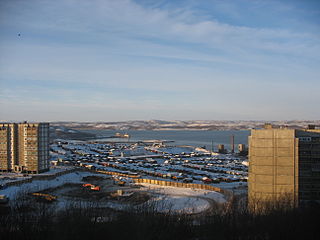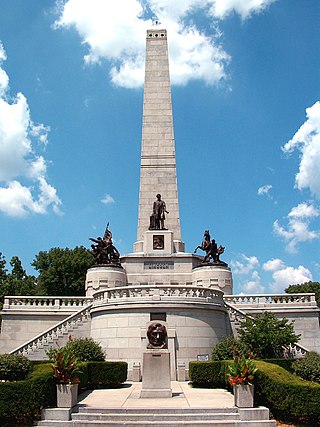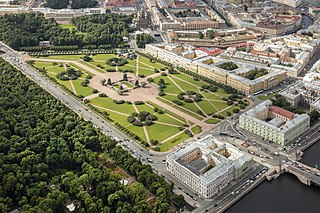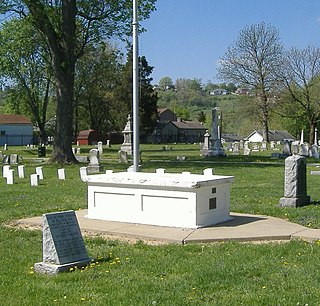
Murmansk is a port city and the administrative center of Murmansk Oblast in the far northwest part of Russia. It sits on both slopes and banks of a modest ria or fjord, Kola Bay, an estuarine inlet of the Barents Sea., with its bulk on the east bank of the inlet. It is in the north of the rounded Kola Peninsula which covers most of the oblast. The city is 108 kilometres (67 mi) from the border with Norway and 182 kilometres (113 mi) from the border with Finland.

The Washington Monument is an obelisk on the National Mall in Washington, D.C., built to commemorate George Washington, a Founding Father of the United States, victorious commander-in-chief of the Continental Army from 1775 to 1784 in the American Revolutionary War, and the first President of the United States from 1789 to 1797. Standing east of the Reflecting Pool and the Lincoln Memorial, the monument, made of marble, granite, and bluestone gneiss, is both the world's tallest predominantly stone structure and the world's tallest obelisk, standing 554 feet 7+11⁄32 inches (169.046 m) tall, according to the U.S. Geodetic Survey measurements in 2013–2014. It is the tallest monumental column in the world if all are measured above their pedestrian entrances. It was the world's tallest structure between 1884 and 1889, after which it was overtaken by the Eiffel Tower, in Paris. Previously, the tallest structure was the Cologne Cathedral.

Severomorsk, known as Vayenga (Ваенга) until April 18, 1951, is a closed town in Murmansk Oblast, Russia. Severomorsk is the main administrative base of the Russian Northern Fleet. The town is located on the coast of the Barents Sea along the Kola Bay 25 kilometers (16 mi) northeast of Murmansk, the administrative centre of the oblast, to which it is connected by railway and a motorway.

The Lincoln Tomb is the final resting place of Abraham Lincoln, the 16th President of the United States; his wife Mary Todd Lincoln; and three of their four sons: Edward, William, and Thomas. It is located in Oak Ridge Cemetery in Springfield, Illinois.

The Allied intervention in the Russian Civil War consisted of a series of multi-national military expeditions that began in 1918. The initial impetus behind the interventions was to secure munitions and supply depots from falling into the German Empire's hands, particularly after the Bolsheviks signed the Treaty of Brest Litovsk, and to rescue the Allied forces that had become trapped within Russia after the 1917 October Revolution. After the Armistice of 11 November 1918, the Allied plan changed to helping the White forces in the Russian Civil War. After the Whites collapsed, the Allies withdrew their forces from Russia by 1925.

The North Russia intervention, also known as the Northern Russian expedition, the Archangel campaign, and the Murman deployment, was part of the Allied intervention in the Russian Civil War after the October Revolution. The intervention brought about the involvement of foreign troops in the Russian Civil War on the side of the White movement. The movement was ultimately defeated, while the British-led Allied forces withdrew from Northern Russia after fighting a number of defensive actions against the Bolsheviks, such as the Battle of Bolshie Ozerki. The campaign lasted from March 1918, during the final months of World War I, to October 1919.

The Field of Mars is a large square in the centre of Saint Petersburg. Over its long history it has been alternately a meadow, park, pleasure garden, military parade ground, revolutionary pantheon and public meeting place.

Luxembourg American Cemetery and Memorial is a Second World War American military war grave cemetery, located in Hamm, Luxembourg City, Luxembourg. The cemetery, containing 5,074 American war dead, covers 50.5 acres (20.4 ha) and was dedicated in 1960. It is administered by the American Battle Monuments Commission.

The Ogle County Courthouse is a National Register of Historic Places listing in the Ogle County, Illinois, county seat of Oregon. The building stands on a public square in the city's downtown commercial district. The current structure was completed in 1891 and was preceded by two other buildings, one of which was destroyed by a group of outlaws. Following the destruction of the courthouse, the county was without a judicial building for a period during the 1840s. The Ogle County Courthouse was designed by Chicago architect George O. Garnsey in the Romanesque Revival style of architecture. The ridged roof is dominated by its wooden cupola which stands out at a distance.

The Soldiers' Monument is a memorial consisting of three statues, one in bronze and two in marble by sculptor Lorado Taft, grouped around an exedra designed by the architectural firm of Pond and Pond. It is located in Oregon, Illinois, the county seat of Ogle County, Illinois. It was dedicated in 1916. The sculpture is part of the Oregon Commercial Historic District. The district was designated and listed on the National Register of Historic Places in August 2006.

The Veteran's Monument, also called the War Between the States Veteran's Memorial, in Linden Grove Cemetery of Covington, Kentucky was built in remembrance of both Union and Confederate veterans of the American Civil War. It is one of only two memorials in the Commonwealth of Kentucky that celebrate soldiers of both sides of the conflict. The American Legion dedicated the monument on May 30, 1933, which was that year's Memorial Day.

The Grand Army of the Republic Monument, in the Linden Grove Cemetery of Covington, Kentucky, was built in 1929 by the O. P. Sine of Garfield Post No. 2 of the Grand Army of the Republic, a group comprising the remaining veterans of the Union army.

The Russian Civil War (1917–1921) began after the provisional government collapsed and the Bolshevik party assumed power in October 1917. The principal fighting occurred between the Bolshevik Red Army and the forces of the White Army, a group of loosely allied anti-Bolshevik forces. During the war several foreign armies took part, mostly fighting against the Red Army—including the Western allies—and many foreign volunteers fought for both sides. Other nationalist and regional political groups also participated in the war, including the Ukrainian nationalist Green Army, the Ukrainian anarchist Black Army and Black Guards, and warlords such as Ungern von Sternberg. Despite some pressure from Britain, the Australian Prime Minister, William Hughes, had refused to commit forces to Russia following the end of World War I in 1918.

The Zebrnjak Memorial is a war memorial commemorate the Battle of Kumanovo, fought in 1912 as part of the First Balkan War. It is situated on the battlefield, close to the village of Mlado Nagoričane, near Kumanovo, North Macedonia.

To the Defenders of the Soviet Arctic during the Great Patriotic War, commonly called Alyosha is a monument in Murmansk, Russia to Soviet soldiers, sailors, and airmen of World War II.

Boonah War Memorial and Memorial Park is a heritage-listed memorial at Park Street, Boonah, Scenic Rim Region, Queensland, Australia. It was built from 1920 to 1922. It was added to the Queensland Heritage Register on 21 October 1992.

St Monica's Cathedral is the cathedral church of the Catholic Diocese of Cairns. It is located at 183 Abbott Street, Cairns City, Cairns, Queensland, Australia. The cathedral was designed by Ian Ferrier and built from 1967 to 1968. It was added to the Queensland Heritage Register on 31 August 1998.

The Park of 28 Panfilov Guardsmen is an urban park located in east-central Almaty in the area surrounding the Ascension Cathedral. It is dedicated to and named after the Panfilov heroes which were the 28 soldiers of an Alma-Ata Infantry unit who allegedly died while defending Moscow from the German invasion during the Second World War. The group took its name from Ivan Panfilov, the General commanding the 316th division which, in spite of heavy casualties, believed at that time managed to significantly delay the Germans advance to Moscow, thus buying the time for the defenders of the city. An eternal flame commemorating the fallen of the World War II and the Eastern Front burns in front of the giant black monument of soldiers from all 15 Soviet Republics.

Coventry War Memorial stands at the centre of War Memorial Park, to the south of the city of Coventry in England. The memorial is a tapering tower 87 feet (27 m) high, completed in 1927. It was restored in 2011, and designated as a Grade II* listed building in January 2013. At the same time, the park was itself listed at Grade II, and the gates and gate posts at the park's main entrance were separately Grade II listed.

The Supreme Administration of the Northern Region was an anti-Bolshevik left-wing Allied government part of the White movement during the Russian Civil War.





















